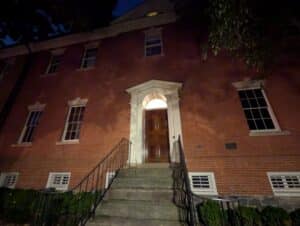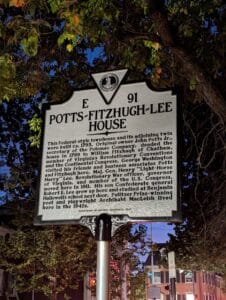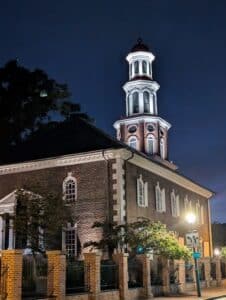Visiting Robert E. Lee Sites in Northern Virginia
I just finished reading a biography of Robert E. Lee, so on my recent trip to Washington, D.C., I had to check out some Lee-related sites. Arlington is most closely associated with Lee, but the general spent much of his adolescence within the District of Columbia in Alexandria. Of course, Alexandria belongs to Virginia now (it was retroceded from the District to the Commonwealth of Virginia in 1847), but Lee’s boyhood home still stands on Oronoco Street in Old Town.

Robert Lee and his family moved to Alexandria from his birthplace at Stratford Hall in 1811, after his father— Henry “Light Horse Harry” Lee—experienced financial trouble. Shortly after the family settled into their townhouse on Oronoco Street, Light Horse Harry left for the West Indies, never to return to his family. It was here in Alexandria that Lee grew up fatherless.

It was also in Alexandria that Lee likely first met his wife, Mary Anna Randolph Custis. Robert Lee and Mary Custis shared many of the same relatives (Lee’s mother and Custis’s mother were second cousins) and shared the same social circles in antebellum Alexandria. The couple courted and married in 1831 at the Custis estate, Arlington—located five miles north along the Potomac River from Lee’s boyhood home.
Arlington belonged to Mary’s father, George Washington Parke Custis, and not to Robert E. Lee. In fact, Lee never legally owned the estate despite its everlasting connection to him in the public zeitgeist. When George Washington Parke Custis died in 1857, he willed Arlington to Mary. In the event of her death, the mansion was to be passed to Custis Lee, the couple’s oldest son. Not only did Custis effectively cut his son-in-law out of his will, but he also entrusted Lee with the thankless job of executing it.
Nonetheless, Arlington represents an important place in the life of the future Confederate general. Lee resided at the estate with his wife, children, and in-laws in between his postings with the U.S. Army Corps of Engineers. It’s also where Lee returned after his fateful meeting with Francis Preston Blair in April 1861 and where he later made the series of decisions that led to his resignation from the U.S. Army and pledging his service to the Confederacy.
Back in Alexandria, the belfry of Christ Church towers over the surrounding town. This is where Lee worshiped during both his childhood and adulthood, and the church where his father had belonged before his disappearance to the West Indies. Although Lee attended services alongside his family, he was not confirmed in the Episcopal Church until he turned 46. Decades before Lee, George Washington regularly attended Christ Church. The pews of both families (the Washingtons and the Lees) are marked today.

Lee’s shadow looms large over Northern Virginia, from Alexandria to Arlington. From his boyhood home to his wife’s beloved Arlington to his storied place of worship, the southern banks of the Potomac are rich with the history of the Confederacy’s greatest general.

Evan
I apologize if I am wrong but I don’t think the City of Alexandria was ever part of DC. The County of Alexandria, later Arlington County, was retroceded to Virginia. In Virginia, counties and cities are legally separate but towns are part of counties, which makes for a good bar exam question.
I’m sure Madeline could speak more to this question that I can, but everything I’ve read has referenced Alexandria as part of the district until 1847.
You are correct. Not all of what is now the city of Alexandria was part of DC, but the old town part was, so I stand corrected. I guess I forgot that part of my third grade Arlington County history.
Evan is correct, Alexandria, the city, was part of DC. https://www.alexandriava.gov/historic-alexandria/a-brief-history-of-alexandria
Yea, the whole concept of shifting borders of DC is interesting. My students generally get confused each semester when we discuss DC’s origins, how it changed shape, and how it had numerous cities within.
Great piece! The museum where I work (Lee-Fendall House Museum) is right across the street from the Boyhood Home at 614 Oronoco Street. It was the home of Lee’s Aunt Mary, Uncle Philip Fendall, and first cousins. We have a lot of Lee family pieces here 🙂 Feel free to stop by for a visit.
Thanks! I passed Lee-Fendall and thought of you! I’d love to stop by for a visit sometime!
Nice info, may I suggest a site that no longer stands but has historic markers – Lee honeymooned with his wife Mary at the 8,000-acre Ravensworth estate in Northern Virginia’s Fairfax County, and that another possible site, if you’ve got a full day in Northern Virginia, is that the battle of Ox Hill was fought in Northern Virginia, where gallant General Phil Kearny died in battle, and General Lee arrived at it’s conclusion. Lee directed General Kearny’s deceased remains be returned to the AOP under flag of truce, this transpiring just before Lee headed his army off to destiny at Antietam.
Ox Hill is on my bucket list to visit, but I didn’t know Ravensworth was close by!
Great post! What biography of Robert E. Lee did you read?
Thank you! It was Robert E. Lee: A Life by Allen Guelzo
My wife and I have actually attended a few services at Christ Church and sat in the Lee pew box. Washington’s box is nearby.
Cool!
Excellent post. I think because of his father’s absence and early death, ironically tied to both parent’s old and strong ties to specific locations in Virginia, Lee found great emotional strength in a sense of place. But this apparently emotionally conservative man was also a restless individual, breaking the bonds of place. His career as a devotee of long range reconnaissance in Mexico, the willingness to take a risk, always warred with the tidy engineer for his soul. Sometimes I think the meticulous Longstreet and the bolder Jackson were just the twin reflections of his own soul. The loss or wounding of them, as well as the knight errant Stuart, but into him deeply.
Thanks, John. That’s quite the poetic description of Lee! I think Lee certainly felt his father’s absence throughout most of his life. But it’s worthy to note that, despite Lee’s proclaimed loyalty to Virginia, he spent very little time in his “native state.” When Lee grew up, Alexandria was part of the District of Columbia. Even after it was retroceded in 1847, Lee spent much of his life on assignment with the US army in New York, St. Louis, Mexico, and many other places. His loyalty to his “native state” was probably more rooted in familial as well as financial ties. But nonetheless, his sense of place is certainly a fascinating topic.
I may be ignorant on this matter, but didn’t R E Lee pledge allegiance to Virginia, not the Confederacy?
You’re correct, he didn’t pledge allegiance to the Confederacy at first. Only Virginia. But eventually Lee accepted a commission in the Confederate army, thereby pledging his allegiance to the Confederacy.